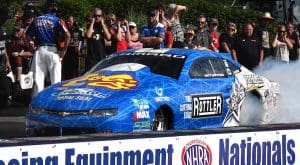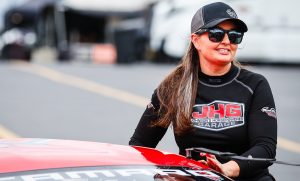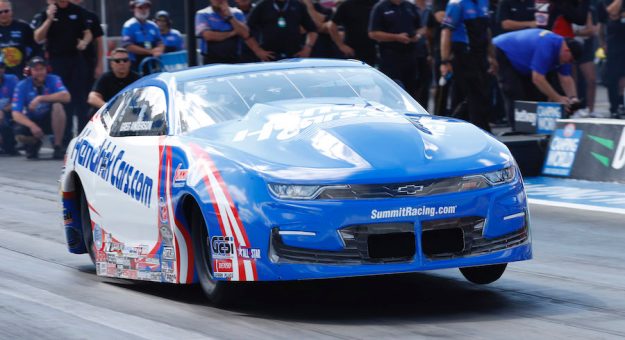Last June when the NHRA Camping World Drag Racing Series visited New England Dragway in Epping, N.H., five-time Pro Stock champion Greg Anderson was at home in North Carolina.
It was one of three times during the 21-event NHRA season that the longtime racer was relegated to the role of bystander, watching Top Fuel dragsters and Funny Cars blast down the drag strip while he sat in angst on his couch.
Ever since NHRA made Pro Stock a part-time series in 2019 and cut the class’s schedule from 24 races to 18, the arrangement had become an unpleasant routine for Anderson.
Originally, the decision was meant to benefit the segment of drivers who held day jobs and had obligations other than racing, as the travel schedule and need for crew members was seemingly reduced by 25 percent.
Not only that, but the popularity of the factory hot rod class was waning and NHRA officials believed that reducing the number of races would help it survive.
“Four, five years ago the Pro Stock class was kind of in trouble and it was having trouble getting 16 cars to show up,” Anderson recalled. “I was shocked when we stopped (racing full time), but I understood (NHRA’s) decision.”
However, understanding and agreeing are two different things.
“It was painful to sit home on a weekend and tune into NHRA.tv,” Anderson said. “It just didn’t feel right. It never felt right and I didn’t like it from day one.”
Since entering the NHRA arena in 1998, Anderson has witnessed innumerable changes take place in the Pro Stock class — some good, some bad. The 62-year-old still remembers the days before he found his place behind the wheel, when he worked on the crew for six-time Pro Stock champion Warren Johnson.

“He was a great racer and had a great race team, but to be honest with you, he was one of two or three or four of the top-echelon race teams that could win races. That was pretty much it,” Anderson explained.
“Of your 16 qualified cars, there was four or five that had a chance to win. The rest were just too far behind.”
In the modern era of Pro Stock, it’s not like that.
While it’s more challenging for Anderson to add to his Wally collection, he welcomes the new wave of competition and hard-nosed style of racing that many of the young guns of the class exhibit.
Drivers such as Aaron Stanfield, Kyle Koretsky, Dallas Glenn, Troy Coughlin Jr., Camrie Caruso, Matt Hartford and Cristian Cuadra are a few of the drivers who have emerged from the woodwork over the last few seasons.
“I’ve always heard Pro Stock is the most challenging drag car to drive,” said third-generation driver Stanfield, who races under the Elite Motorsports banner. “It kicks my butt over and over again, and I keep coming back for some more.
“People like Erica (Enders) and Greg (Anderson) make it look easy, but it’s a tough class.”
In three years, the 26-year-old Stanfield has earned eight Pro Stock victories. The recent rise in Pro Stock’s popularity led NHRA to reinstate the professional class as full time beginning this season.
“All is right again in the Pro Stock world,” Anderson said, his face tugging into a smile.
The 101-time national event winner pointed to both a cause and effect that resulted in Pro Stock’s internal growth spurt and its outward recognition from NHRA. The “cause” involves an understanding that Anderson came to with powerhouse team Elite Motorsports several years ago, in the midst of Pro Stock’s downturn.
“We basically both looked at each other, we swallowed our pride and we decided to do something that we thought would be good for the class and that would be to rent competitive rides — just as good an engine as we race in our own cars,” Anderson said.
The deal was that any interested driver could join KB Racing (Anderson’s team) or Elite Motorsports (owned by Richard Freeman), show up to a race track with their helmet and jump in a race car that was equal to the title-winning machines that Anderson and six-time champion Erica Enders pilot.
“We made it affordable and we gave them the same equipment we got and then that branched out into renting race cars, race tuners — the whole enchilada,” Anderson explained.
It resulted in a surge of interest, and both teams quickly saw results. This past season, KB Racing fielded four full-time cars while Elite powered eight.
Anderson believes the new arrangement has “changed the landscape” for the better, although once again, it’s increased the level of difficulty he faces when it comes to parking his HendrickCars.com Chevrolet in the winner’s circle.
But that’s a consequence he’s willing to live with.
The key effect of having more Pro Stock cars on the drag strip, providing more thrills and competition for crowds to witness, was that more fans re-engaged with the class.

“I think NHRA finally got enough hate mail about us not being at certain events that they were like, ‘OK, you can come back,’” said Enders, who made her Pro Stock debut in 2005.
Anderson added, “There’s a lot of people out there who love Pro Stock. I think (NHRA) heard a lot of that in the last couple years. Some of the race tracks we didn’t go to, a lot of fans asked for it to come back and complained.”
While it’s certainly a victory for Pro Stock as a whole, there are both negatives and positives that come with NHRA’s call to make it full time.
Enders and Anderson can attest to both.
“It’s three more races and three more weeks on the road for my guys and that much more funding that we’ve got to put together,” 40-year-old Enders noted.
Meanwhile, Anderson is on the opposite end of the spectrum.
“It was a problem when we first cut back to the 18 (races) because that’s absolutely the first thing a lot of sponsors did, was they divided the number of races you sat out by the amount of money they paid,” Anderson said. “It was a tough deal, because you still had payroll.”
Sure, the schedule allowed race teams to cut down on a few travel costs here and there, but for the KB Racing team owner, it wasn’t quite that simple.
“You couldn’t lay your people off for those races, so the expenses were still there. They’re still full-time employees,” Anderson said. “And I can tell you for a fact for myself and I’m sure the Elite team, when we had those weekends off, we still worked at our shop.”
The bottom line was that being a part-time class created a trade-off among sponsors, race teams and drivers where some people lost and some won.
But arguably, that’s a natural part of any sport.
Freeman, who owns and operates Elite Motorsports, isn’t sure if going back to a full schedule is the answer, though he does agree that the competition in Pro Stock has risen and it deserves some sort of recognition.
“I think we have to try and see if we don’t lose car count, because if we start losing car count because of it, we have to back up,” Freeman said. “I don’t know that (21) is the number. I really like 18, but I do think everyone should be there.”
